|
|
 |
|
Calanoida ( Order ) |
|
|
|
Clausocalanoidea ( Superfamily ) |
|
|
|
Diaixidae ( Family ) |
|
|
|
Byrathis ( Genus ) |
|
|
| |
Byrathis arnei Schulz, 2006 (F, M) | |
| | | | | | | Ref.: | | | Schulz, 2006 (p.60, Descr. F, Descr. copepodid V Male; figs.F, M5, Rem.: p.67); Markhaseva & Renz, 2011 (p.61, Descr.M, figs.M) | 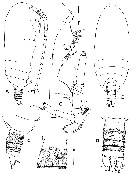 issued from : K. Schulz in Mitt. hamb. zool. Mus. Inst., 2006, 103. [p.61, Fig.8]. Female (from 74°36.2'S, 27°15.8'W): A-B, habitus (lateral and dorsal, respectively); C-D, urosome (lateral and ventral, respectively); E, genital double-somite; F, head (anterior part; lateral view; postoral buttress dividing posterior and terminal setae of praecoxal maxillary arthrite arrowed); G, A2. Scale bars: 0.05 mm. Nota : Rostrum bluntly rounded with pair of very small, closely adjacent filaments directing posteriorly. A1 24-segmented, extending to posterolateral corner of prosome. Body slender, with comparatively short urosome. Prosome about 4.2 times length of urosome. Cephalosome, in lateral view, a pair of postoral, strong chitinous protrusions. Cephalosome and pediger 1 fused, pedigers 4 and 5 separated but ventrolateral edge fused. Posterolateral corners of prosome extend posteriorly into angular lappets that cover about 2/3 of genital double-somite. Urosome 4-segmented, surfaces of segments widely covered with spinules ; posterior border of urosomites except anal somite with serrated hyaline frill. Genital double-somite symmetrical, bulging ventrally and laterally. Spermathecae slender, digitate process extending dorsoposteriorly. Anal somite visible both dorsally and ventrally. Caudal rami with 6 setae, symmetrical, 1.25 times longer than wide ; seta II small, located slightly anterodorsally with respect to base of seta III ; strong terminal setae III and Vi (detached in all specimens) ; seta IV and V present ; seta VII short, plumose, slightly longer than seta II and situated on anteroventral surface of caudal ramus. A2 with endopod more slender than exopod ; exopod about 1.9 times longer than endopod ; coxa with 1 seta and posterior row of long spinules ; basis with 2 setae ; endopodal segment 1 with 1 subdistal seta, segment 2 with 6+6 setae ; exopod indistinctly 8-segmented with 11 setae visible, segment 1 (ancestral I) with 1 scar (probably detached seta in all specimens), segment 2 (ancestral II-IV) with 3 subequal setae, segment 3 (ancestral V) with 1 seta, not clearly separated from segment 2, segment 4-8 (ancestral VI-XI, X-XI being fused) with 1, 1, 1, 1, 3 setae.
|
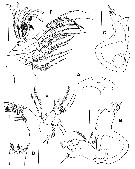 issued from : K. Schulz in Mitt. hamb. zool. Mus. Inst., 2006, 103. [p.63, Fig.9]. Female: A, rostrum (ventral view); B, Md; C, Md (mandibular gnathobase); D, Md (cutting blade); E, Mx1; F, Mx2. Scale bars: 0.05 mm. Nota : Md : gnathobase short with strongtooth-like projection (crest) on posterior surface, cutting edge with 7 teeth and 1 dorsal seta surpassing tip of dorsalmost tooth by far ; basis with 3 subequal setae ; endopod 2-segmented with 2 and 9 setae ; exopod bearing 6 setae. Mx1 : praecoxal arthrite comparatively large compared to rest of appendage, with 9 terminal spines, 1 small anterior seta and 2 posterior surface setae ; proximalmost terminal spine longer than remaining spines and continuously curved distad ; coxal endite and basal endite 1 with 2 setae each ; basal endite 2 bearing 3 unequal setae ; endopod 2-segmented and separated from basis, with groups of 2+4 and 3 setae ; exopod with 5 setae ; coxal epipodite with 9 setae. Mx2 : praecoxal endites 1 and 2 short, with 5 and 3 setae, respectively ; coxal endites 1 and 2 comparatively long, with 3 unequal setae eaxh, distal seta of coxal endite 2 strong, spinulose and claw-like ; basal endite comparatively long, with 2 long setae, 1 worm-like sensory seta and 1 spinulose, claw-like seta ; endopod 2-segmented with 5 long worm-like and 3 shorter brush-like sensory setae, 1 of them shorter and bearing larger brush-like head than others.
|
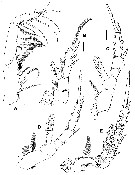 issued from : K. Schulz in Mitt. hamb. zool. Mus. Inst., 2006, 103. [p.64, Fig.10]. Female: A, Mxp; B, P1 (anterior surface); C, P2 (posterior surface); D, P3 (posterior surface); E, P4 (posterior surface). Scale bars: 0.05 mm. Nota : Mxp : syncoxa and basis of equal length. Syncoxa with comparatively pronounced endites bearing 1, 2, 3 setae ; endite 1 with tuft of small spinules proximal to base of long seta ; endite 2 with 1 short and 1 long setae ; endite 3 with 2 small setae and 1 brush-like sensory seta having distal head strongly curved proximally ; endite 4 with patch of spinules proximally and 3 unequal setae. Basis with 3 medial setae (2 proximal setae closer together than 2nd and 3rd seta), and longitudinal row of tiny spinules extending from proximal to distalmost seta. Endopodal segment 1 indistinctly incorporated into basis, with 2 setae ; segments 2-6 with 4, 4, 3, 3+1, and 4 setae.
|
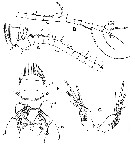 issued from : K. Schulz in Mitt. hamb. zool. Mus. Inst., 2006, 103. [p.66, Fig.8, A-C, E]. Female: A, A1 segments 1 to 13 (ancestral: I to XVI); B, A1 segments 14 to 24 (ancestral: XVII to XXVIII); C, P5 (posterior view); E, oral frame: Pair of ventral protrusions postoral protrusions (vp, stippled); p = paragnaths; pa = praecoxal arthrite of Mx1; ps = 2 posterior setae; ul = upper lip. Scale bars: 0.05 mm. Nota : A1 24 segments, with 2 proximal setae of segment 1 (ancestral segment I) plumose ; inner distal seta of segment 22 (ancestral segment XXV) longest. Segmentation (ancestral number in Roman numeral; s = seta, ae = aesthetasc) pattern and setation : I = 3s+ 1ae ; II-IV = 6s + 1ae ; V = 2s+ 1ae ; VI = 2s ; VII = 2s + 1ae ; VIII = 2s ; IX = 2s + 1ae ; X-XI = 4s + 1ae ; XII = 1s ; XIII = 1s ; XIV = 2s + 1ae ; XV = 1s ; XVI = 2s + 1ae ; XVII = 1s ; XVIII = 2s ; XIX = 1s ; XX = 2s ; XXI = 1s + 1ae ; XXII = 1s ; XXIII = 1s ; XXIV = 1s + 1s ; XXV = 1s + 1s ; XXVI = 1s + 1s ; XXVII-XXVIII = 5s + 1ae. P5 uniramous, symmetrical, 3-segmented and ornamented with spinules on posterior surface. Coxae connected by intercoxal sclerite, with short and compact spinules along outer half of distal border. Basis with scattered spinules on outer half. Exopod 1-segmented and heavily covered in small spinules, bearing 2 spines and 2 terminal spine-like extensions all decorated with spinules along their lengths ; outer spine slender about size of outer terminal spine-like extension, latter slightly longer than exopod ; inner spine slightly shorter than inner terminal extension and extending to tip of outer terminal extension. Oral frame in ventral view) : Labrum (upper lip ; labium with paragneths and pair of postoral, strong chitinous protrusions around which 2 posterior and terminal setae of Mx1 praecoxal arthrite lie.
|
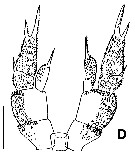 issued from : K. Schulz in Mitt. hamb. zool. Mus. Inst., 2006, 103. [p.61, Fig.8]. Copepodid V male: P5 (posterior view).
|
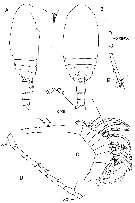 issued from : E.L. Markhaseva & J. Renz in Zootaxa, 2011, 2889. [p.62, Fig.10]. Male (from 64°29'S, 02°53'E): A-B, habitus (lateral and dorsal, respectively; rostrum and caudal rami marked by arrows); C, A1 segments 1-9 (ancestral: I-XIII); D, A1 segments 10-17 (ancestral: XIV-XXI); E, A1 segments 18-22 (ancestral: XXII-XXVIII). Scale bars: 0.1 mm. Nota : Prosome 2.30-2.75 times as long as urosome. Rostrum a plate with 2 filaments. Cephalosome and pedigerous somite 1 fused, pedigerous somites 4 and 5 separate ; posterior corners rounded. A1 22-segmented both right and left sides, symmetrical, extending to urosomal segment 2. Armature setation pattern (s = seta ; ae = aesthetasc ; ancestral segment in Roman numeral) : I = 1s + 1 ae ; II-IV = 6s + 4ae ; V = 2s + 2ae ; VI = 2s + 1ae ; VII = 2s + 2ae ; VIII = 1s + 1ae + ?; IX = 2s + 2ae ; X-XII = 3s + 1 ? + 2ae ; XIII = 1s ; XIV = 2s ; XV = 1s ; XVI = 1s + 1ae ; XVII = 1s ; XVIII = 1s ; XIX = 1s ; XX = 1s ; XXI = 1s ; XXII^XXIII = 1s ; XXIV : 2s ; XXV = 2s ; XXVI = 2s ; XXVII-XXVIII = 4s + 1ae. Urosome of 5 somites, anal somite very short (hiden). Caudal ramus with 2 terminal, 1 ventral and 1 dorsolateral setae.
|
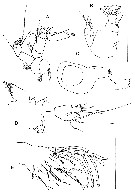 issued from : E.L. Markhaseva & J. Renz in Zootaxa, 2011, 2889. [p.63, Fig.11]. Male: A, A2; B, Md (mandibular palp); C, Md (mandibular gnathobase); D, Mx1; E, Mx2. Scale bars: 0.1 mm. Nota : A2 : coxa with 1 seta ; basis with 2 setae (1 very small) ; exopod 8-segmented with 1, 1-1-1, 1, 1,1, 1, 1, and 3 setae ; 1st endopodal segment without seta, 2nd with 6+7 setae . Md : gnathobase with low crest and 7 teeth on cutting edge plus dorsal seta, lateral tooth situated apart from the remaining teeth ; basis with 2 rudimentary setae ; exopod 5-segmented with 1, 1, 1, 1, and 2 setae ; endopodal segment 1 with 2 setae, 2nd segment with 9 setae. Mx1 : praecoxal arthrite with 9 terminal thin spines ; coxal endite with 2 setae ; proximal basal endite with 2 setae, distal basal endite with 2 setae ; endopod with 7 setae ; exopod with 5 setae ; coxal epipodite with 4 setae. Mx2 : praecoxal endite (previously considered as proximal praecoxal endite) with 4 setae ; coxal endite (previously considered as distal praecoxal endite) with 3 setae ; proximal basal endite (previously considered as proximal coxal endite) with 2 setae ; distal basal endite (previously considered as distal coxal endite) with 3 setae ; enditic-like lobe of proximal endopodal segment (previously considered as proximal basal endite) with 4 setae, 2 sensory ; endopod with 5 worm-like and 3 brush-like sensory setae.
|
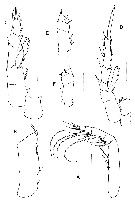 issued from : E.L. Markhaseva & J. Renz in Zootaxa, 2011, 2889. [p.64, Fig.12]. Male: A, Mxp (basis and endopod); Mxp (syncoxa); C, P1; D, P2; E, P3 (coxa, basis, segment of endopod and exopod); F, P4 (coxa, basis, segment 1 of endopod and exopod). Scale bars: 0.1 mm. Nota : Mxp : syncoxa with 1 seta on proximal praecoxal endite, 1 seta on middle, and 1 brush-like seta on distal praecoxal lobe ; coxal lobe with 2 setae. Basis with 3 setae. Endopod 6-segmented with 2, 4, 4, 3, 3, and 4 setae.
|
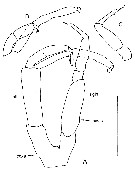 issued from : E.L. Markhaseva & J. Renz in Zootaxa, 2011, 2889. [p.65, Fig.13]. Male: A, P5; B, left P5 (endo- and exopod other specimen); C, right P5 (exopod, other specimen). Scale bar: 0.1 mm. Nota: P5 nearly half as long as the urosome, legs of about equal lengths ; in left coxa and basis only slightly longer than right. Right leg uniramous, exopod 3-segmented. Left leg biramous, exopod 3-segmented, distal segment with subdivided chitinous lamella ; endopod 1-segmented, much longer than exopod.
| | | | | NZ: | 2 | | |
|
Distribution map of Byrathis arnei by geographical zones
|
| | | | | | | Loc: | | | Antarct. (N & E Weddell Sea) | | | | N: | 2 | | | | Lg.: | | | (975) F: 1,38-1,4; (1088) F: 1,25-1,35; 1,33-1,67; M: 1,4-1,55; {F: 1,25-1,67; M: 1,40-1,55} | | | | Rem.: | epibenthic (1573-1535 m; 2000-3050 m).
Markhaseva & Renz (2011, p.66) attribute their females and males to B. arnei although tey differ somewhat from females defined by Schulz (2006) : smaller size (1.25-1.35 mm) ; Mx1 coxal epipodite with 8 setae (vs. 9 setae in specimens from the type series) ; Mx2 praecoxal endite with 4 setae (vs. 5 setae in type specimens) ; distal seta on middle praecoxal endite of Mxp syncoxa slightly longer than figured for type specimen. Additional collections from different localities are necessary to discuss whether the variability observed is interspecific, or whether a new species should be estabished for the authors’ specimens. | | | Last update : 30/12/2014 | |
|
|
 Any use of this site for a publication will be mentioned with the following reference : Any use of this site for a publication will be mentioned with the following reference :
Razouls C., Desreumaux N., Kouwenberg J. and de Bovée F., 2005-2025. - Biodiversity of Marine Planktonic Copepods (morphology, geographical distribution and biological data). Sorbonne University, CNRS. Available at http://copepodes.obs-banyuls.fr/en [Accessed October 28, 2025] © copyright 2005-2025 Sorbonne University, CNRS
|
|
 |
 |












